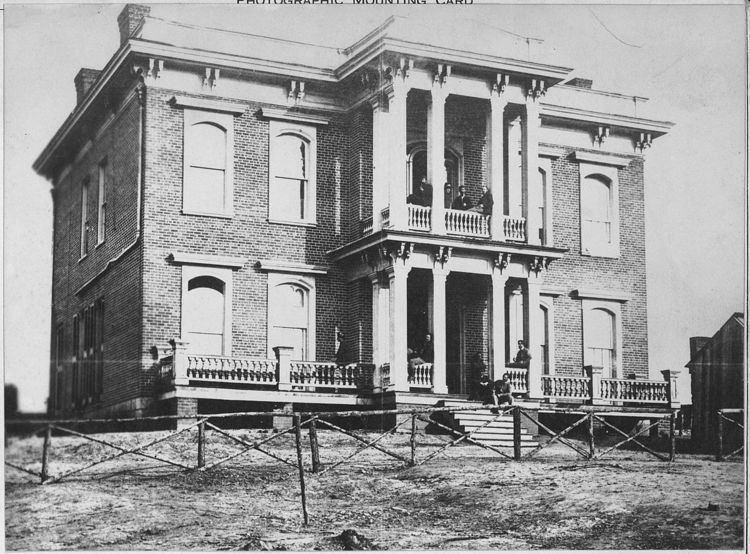Active 1838 – 63 Branch Regular Army | Allegiance United States Army | |
 | ||
Country United States of America Notable
commanders John James Abert (1838-61)
Stephen Harriman Long (1861-63) | ||
The U.S. Army Corps of Topographical Engineers, authorized on 4 July 1838, consisted only of officers and was used for mapping and the design and construction of federal civil works such as lighthouses and other coastal fortifications and navigational routes. It included such officers as George Meade, John C. Frémont and Stephen Long. It was merged with the United States Army Corps of Engineers on 31 March 1863, at which point the Corps of Engineers also assumed the Lakes Survey District mission for the Great Lakes. In the mid-19th century, Corps of Engineers' officers ran Lighthouse Districts in tandem with U.S. Naval officers.
Contents
In 1841, Congress created the Lake Survey. The Survey, based in Detroit, Mich., was charged with conducting a hydrographical survey of the Northern and Northwestern Lakes and preparing and publishing nautical charts and other navigation aids. The Lake Survey published its first charts in 1852.
Significance
William Goetzmann has written:
From the year 1838 down to the Civil War, there existed a small but highly significant branch of the Army called the Corps of Topographical Engineers.... The Engineers were concerned with recording all of the western phenomena as accurately as possible, whether main-traveled roads or uncharted wilderness. As Army officers they represented the direct concern of the national government the settling of the West.... , the Corps of Topographical Engineers was a central institution of Manifest Destiny, and in the years before the Civil War its officers made explorations which resulted in the first scientific mapping of the West. They laid out national boundaries and directly promoted the advance of settlement by locating and constructing wagon roads, improving rivers and harbors, even performing experiments for the location of subsurface water in the arid regions. In short, they functioned as a department of public works for the West - and indeed for the whole nation, since the operations of the Corps extended to every state and territory of the United States.
The work of the Corps in the West had still broader significance. Since a major part of its work was to assemble scientific information in the form of maps, pictures, statistics, and narrative reports about the West, it contributed importantly to the compilation of scientific knowledge about the interior of the North American continent. The Topographical Engineers were sophisticated men of their time who worked closely with the foremost scholars in American and European centers of learning. Scientists and artists of all nationalities accompanied their expeditions as partners and co-workers. The Army Topographer considered himself by schooling and profession as one of a company of savants. By virtue of his West Point training and status he was an engineer, something above the ordinary field officer, whose duties were confined usually to strictly military tasks. As a Topographical Engineer he on occasion might address the American Association for the Advancement of Science. He probably subscribed to Silliman's American Journal of Science and he was a pillar of the Smithsonian Institution.
Major expeditions Prior to the Corps' Creation
In all, there were six major expeditions into the Louisiana Purchase, the first of course being the best known Corps of Discovery led by Lewis and Clark in 1804-1806. A second expedition in 1804 included astronomer and naturalist John Dunbar and prominent Philadelphia chemist William Hunter. This expedition attempted to follow the Red River to its source in Texas, then controlled by Spain, but turned back after three months.
In April 1806 a second Red River Expedition was led by Captain Richard Sparks and included astronomer and surveyor Thomas Freeman and Peter Custis, a University of Pennsylvania medical student who served as the expedition’s botanist. The group of 24 traveled 615 miles up the Red River before being turned back by Spanish authorities. President Thomas Jefferson hoped that this expedition would be nearly as important as the one led by Lewis and Clark, but the interruption by Spanish authorities prevented this hope from being realized.
In 1805–1806, Lieutenant Zebulon Pike was ordered by General James Wilkinson, Governor of the Upper Louisiana Territory, to find the source of the Mississippi River.
In 1806–1807, President Jefferson ordered Lieutenant Pike, on another expedition, to find the headwaters of the Arkansas River and Red River. This is better known as the Pike Expedition. Spanish forces arrested Pike and confiscated his papers, but assigned a translator and cartographer to translate Pike's documents.
In 1817 Major Stephen H. Long explored the upper Mississippi River, selecting sites for Fort Smith on the Arkansas River and Fort St. Anthony at the confluence of the Minnesota and Mississippi.
In 1819, President James Monroe and Secretary of War John C. Calhoun ordered General Henry Atkinson to lead what became known as the Yellowstone Expedition. One objective was to eliminate British influence among the Native American tribes in the region. Nearly 1,000 soldiers were transported by five steamboats up the Missouri River to the Mandan villages at the mouth of the Yellowstone, where they built a fort. This was the first known use of steam propulsion in the west.
